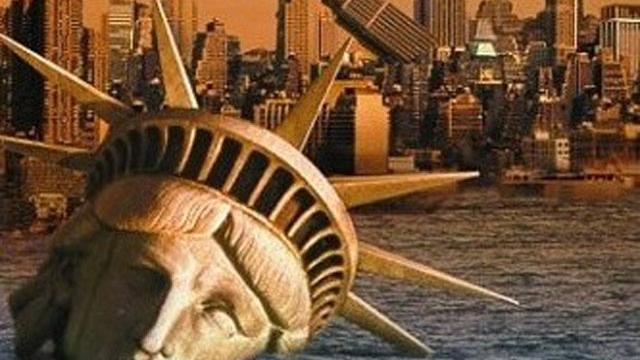Today’s 5.9 magnitude earthquake was felt throughout the mid-Atlantic, but its epicentre — a small town in Virginia — took the brunt of its wrath. What if it had started in NYC instead? We may find out sooner than you think.
The Risk Is Real
New York isn’t very high on the list of places you think of when you think earthquake. But that’s more a lucky accident of the times we live in than a promise of future calm. In the 400 years that we’ve inhabited that small, skinny island off the coast of New Jersey, the city’s been hit at least three times by moderate-to-major earthquakes. A 1737 quake just outside the city limits shook chimneys to the ground. Another struck in 1783. And in 1884, a 5.5-magnitude event cracked the walls of buildings in Jamaica and was felt as far away as Maine. Historically speaking, we’re overdue.
Scientifically speaking, too. A 2008 report in the Bulletin of the Seismological Society of America (PDF) showed that those three were just the perceptible earthquakes suffered by the region; a total of 383 tremors and shakes have occurred in the 39,000sqkm area around NYC since 1677. New York and its environs sit atop a vast networks of several small, active faults and a handful of lines capable of producing 6 and 7 magnitude events that have lain dormant. For now.
Best Case Scenario
The most likely occurrence — a 5ish magnitude quake in or near Manhattan — would be terrifically bad. Not end-of-the-world bad. Not cataclysmic. But horribly traumatic, according to a 2005 study by the New York City Area Consortium for Earthquake Loss Mitigation. The committee, a group of civil engineers, academics, and government officials, spent four years determining the fallout of a significant NYC quake. Let’s hope we never find out if they were right.
I spoke with Dan O’Brian, a Program Manager for the NYS Office of Emergency Management and one of the co-authors of that report. He said that while it was published in 2005, the findings largely hold true six years later. And that the biggest risk isn’t the city’s the towering skyscrapers; it’s the brownstones:
The [structures]that are of a particular concern are unreinforced masonry. The brownstones, six-story, turn of the century. Those are the buildings that don’t have much ability to withstand lateral forces, and they tend to crumble.
So what kind of damage are we talking about? According to the NYCEM report, an event of equal strength to what hit Virginia today would cost approximately $US45 billion (inflation adjusted) in building damage and lost income, with over 2500 buildings damaged and nearly 200,000 people left homeless. Forty tons of debris would cascade the streets, 25 times the amount caused by 9/11. The casualties: 1200 dead, 200,000 wounded.
“You’ve got so much there, if you were to have an epicentre of even a moderate sized earthquake, if it’s epicentered in the immediate NY area you’re likely to see a good bit of damage,” explains O’Brien. Most of that is due to the general building stock.”
The destruction wouldn’t be evenly distributed. Softer soil leads to stronger vibrations; that geological truth, combined with where most of that unreinforced masonry stock is located, make the Upper East Side and Chinatown most vulnerable to a quake. The city’s skyscrapers will hold (to a point), the bridges will survive as well today as they did in 1884. There would be nearly a thousand fires, but the NYFD would have the resources to handle them–assuming the water lines aren’t cut in the quake.
So yes, bad, right. But not doomsday. Although that’s an option, too.
Worst Case Scenario
Did you know that New York City sits less than 40km away from an active nuclear power plant? And that that same power plant sits just a mile south of an active seismic zone that’s considered capable of causing a 6.0-magnitude earthquake? That’s when things get apocalyptic.
The Indian Point nuclear plant, located just north of Manhattan, has provided power to Westchester County and the city itself for decades without incident. But while its operators have claimed that the structures can survive up to a magnitude 6 quake, seismologist Lynn Sykes told the Gotham Gazette recently that he isn’t so sure:
The plants are designed to withstand an event on the intensity scale of VII, which equals a magnitude of 5 or slightly higher in the region. (Intensity measures the effects on people and structures.) A magnitude 6 quake, in Sykes opinion, would indeed cause damage to the plant.
The two reactors provide 10 per cent of the state’s electricity and 30 per cent of NYC’s, meaning that in addition to the destruction outlined in our best case scenario, massive power outages could be expected. If the quake were strong enough to create fractures in Indian Point’s bedrock, radioactive materials could flow freely into the Hudson River. After the events of Fukushima earlier this year, that’s no longer an unthinkable occurrence.
So where does that leave us? We’re in no better or worse shape today than we were yesterday or last month. And the only part of this equation that might change in the next several years is Indian Point, which has been facing political pressure of late and whose contract may not be renewed. But really, the only thing that’s different now is the awareness that it’s not an if, it’s a when. That we’re just running out the clock. And that’s should have us shaking in our boots.
